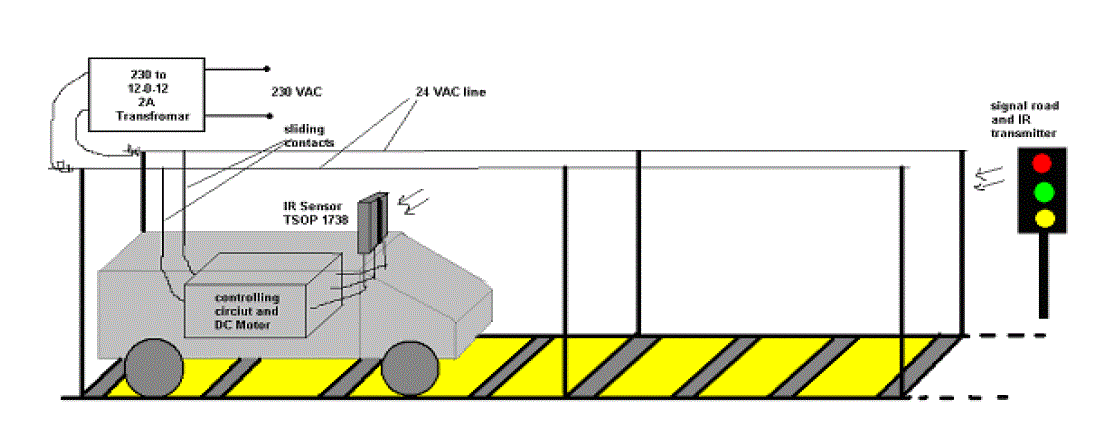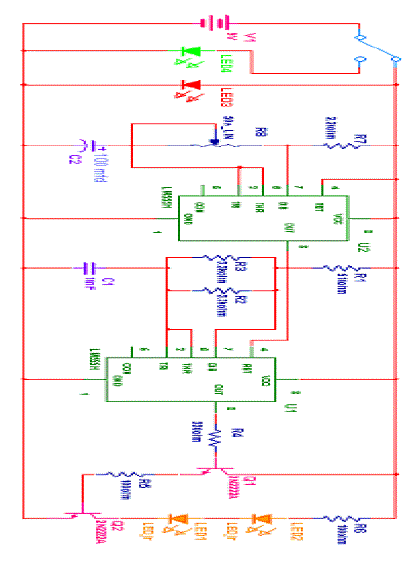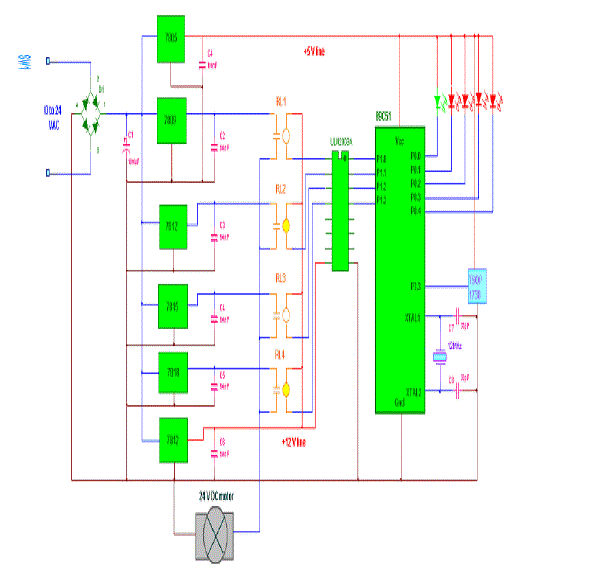This paper describes the design of the intelligent train Engine. These types of engine have capacity to control the train speed in different steps. It is based on the smart timer IC555, IR sensor TSOP1738, MC89C51 the idea is whenever any engine observes a red signal on its track it will start decreasing its speed gradually and stops automatically at some distance from the signal pole. After then when it get green signal the driver can manually start the train and go on. In the mean time when train has not stopped yet and a red signal becomes green then it crosses the signal pole with low speed and then driver can slowly increase the speed.
Keywords |
| Timer IC555, IR sensor TSOP1738, MC89C51, current driver chip ULN2003A and all voltage regulator
ICs(78xx series). |
INTRODUCTION |
| We know that the railway network of India is the biggest in south Asia and perhaps the most complicated in all over the
world. There are so many different types of train local, fast, superfast, passenger, good.etc and their so many multiple
routs. Although the time table is perfect it is not at all possible to maintain it and that’s why the train accidents are
becoming more and more usual. |
| So why not we add a kind to intelligence to the train engines itself so that is tries to avoid accidents. Both the transmitter
and receiver are of RF type with minimum range of 2 km so that train can get enough time to decrease its speed and stop
before the signal pole with minimum swapping distance of 100-200m. |
II. DEMONSTRACTION MODEL |
| The train engine runs on 24 volt DC motor so that we can easily vary its speed by varying applied voltage. The switching
voltage is applied in step of 18V, 15V, 12V, and 9V (minimum speed). The 230 VAC is step down to 24 VAC by 12-0-
12, 2 ampere step down transformer. As shown in fig. this 24 DAC line runs parallel with track at the top of the train.
Movable tapping are taken from this line and fed to the internal circuit of engine, senses the signals transmitted by IR
transmitter attached to signal pole. Train track is straight and 20 ft long. Signal pole is placed at the end of track and train
starts from farther end. |
III. NEED |
| This project is mostly useful for human life and decreasing the ratio of accidents due to the traffic signals. Some points
are given below for decreasing the ratio of accidents due to |
| 1. Fog in winter. |
| 2. Misunderstanding by driver of trains. |
| 3. Suddenly changing in traffic lights. |
| 4. Some technical problems. |
| 5. Controlling system. |
| 6. Timing of signals. |
IV. USED DEVICES |
| There are only two major devices are used in process. |
1) TRANSMITTER |
| The transmitter is housed in signal pole and it is activated only when red light is on. The heart of the circuit is IC555. The
main component of the circuit is only IC555. Both ICs are connected in astable mode. |
| The frequency of U2 is 0.5 Hz and U1 is 38 KHz. This is decided by RC components connected with it. |
| The output of U2 is connected with the 9V DC bettery is connected with circuit through SPDT swith SW1 as shown. As
shown in figure when SW1 is in position as shown the transmitter is on and also the red LED is also ON. When switch
changes its position the red LED and transmitter is off and only green LED will ON. When the circuit is energized U@
will start generating high pulse at every 1 sec. as this pulse is fed to reset pin of U1 it will generate 38 KHz for the same
time. Thus after every one second the IR beam of 38 KHz is generated for one second only. This cycle repeats till the red
light is on. |
2) RECEIVER |
| The receiver is housed in engine which senses the IR signals and takes suitable actin. 24 VAC is rectified by diode
bridge D11 and filtered through C1 and given to all the regulated ICs as input. The output of 7805 is connected to 89C51
and TSOP and also to all the LDs. Output of 7812 (last one) is connected to common coil terminal and to ULN. The
output of middle four regulated ICs are connected to DC motor through relay contacts. Output of TSOP is connected
with pin P3.3 (INT1) of microcontroller. All five LEDs are connected with port P0 as shown input of ULN is connected
with port 1 pins P1.0-P1.3, and outputs are connected with second terminal of relay coil. TSOP will detect the 38 KHz
IR beam and gives the interrupt to 89C51. 89C51 will indicate the interrupt event on first (Green) LED and energized
only one particular relay thought ULN chip. When any of the four relay get energized the motor will get supply from it
and it will start running as voltage is less it will run with less speed. So now it’s the function of microcontroller to receive
signal from IR sensor, decrease the speed of train gradually in four steps and then stop it. And this is done by software
embedded in to 89C51. |
V. CONCLUSION |
| Initially when you switch on the supply 89C51 will switch all the relays RL1- RL4 one by one. So motor will get 9-
12-15-18 V supply in steps and gradually increases its speed reaches max speed indicated by first red LED (P0.0).
Now if the signal is green then train will cross the pole with same pole But if signal becomes red in between then IR
sensor will detect IR beam and interrupts the 89C51 Getting first interrupt 89C51 will switch off RL4 and switch on
RL3 so now motor will get 15 V supply and its speed will be decreased. That’s indicated by second red LED
(P0.1).Now 89C51 will wait for some time (2 to 3 sec) and train goes on with same speed. Again if still red signal is
on 89C51 will be interrupted and this time it will switch on RL2. so now motor gets 12V supply and again its speed
will be decreased indicated by third red LED (P0.2) The same procedure repeats if 89C51 is interrupted third times.
Now motor runs at min speed (9 V) indicated by fourth red LED (P0.3) After same delay on receiving fourth
interrupt all the relays will be switched off and motor is now stop so the train is also stopped. This is indicated by
green LED. After this interrupts will be disabled. So now when red signal becomes green driver must reset the
controller to start the train again. |
ACKNOWLEDGEMENT |
| This project is to avoid the accidents which occur by signal problems and train problems. Before the driver observes
the red signal the engine itself observes it and automatically starts decreasing speed and then stops. The driver can
feel relax in driving because he dose not have to take care about red signal. Even if he forgets to take any action on
red signal then also we can avoid accidents by the implementation of this idea. |
| |
Figures at a glance |
 |
 |
 |
| Figure 1 |
Figure 2 |
Figure 3 |
|
| |
References |
- The IUP Journal of Electrical & Electronics Engineering, Vol. IV, No. 4, pp. 36-47, October 2011.
- Kumar, Sanjeev, Gupta, Shweta and Sharma, Dibyayan Das, An âÃâ¬ÃËIntelligentâÃâ¬Ã⢠Train Engine Based on Auto-Signal Following Scheme Using IRTechnology (July 19, 2012).
- The IUP Journal of Electrical & Electronics Engineering, Vol. IV, No. 4, pp. 36-47, October 2011. Available at SSRNavoid-accidents-andrailway-gate-controlling.
- PublicationnumberEP0935180A2PublicationtypeApplicationPublication dateAug 11, 1999Filing dateFeb 3, 1999Priority date Feb 5, 1998Alsopublished as US6044632 Inventors Seven Christopher Schmalz Russell Paul Schuchmann Joseph Charles Zuercher Eaton Corporation .
- Inventors: Peng-ChengLin,SethR.Sanders, Original Assignee: National SemiconductorCorporationPrimary Examiner: Roy Potter. US4064472Apr 8, 1976Dec 20, 1977Vanguard Electronics Company, Inc.Compact inductor.
- IAN M. Bennett, paloalto,CA(US), patent no. US6, 615,172B1. Date- sep.2,2003. bandirameshbabu,. Andhra pradesh.Phoenix solutions, Incpaloalto, appl. No. 09/439,060, NOV. 12,1999
- LIU Lan~1,WEI Deyong~2, YIN Yuan~1,WEI Fanghua~1 (1.School of Traffic and Transp.,Southwest JiaotongUniversity,Chengdu610031,China;2.The Second Railway Survey & Design Institute,Chengdu 610031,China) http://seminarprojects.com/s/ppt-on-intelligent-trainengine-to-avoid-accidents..
|